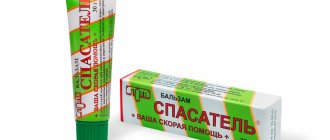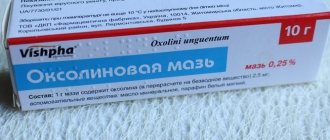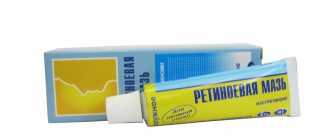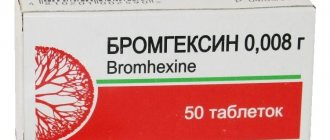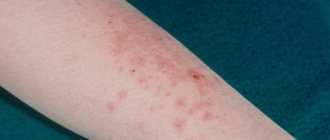- What is oxolinic ointment?
- Features of the appearance and storage of oxolinic ointment
- Indications for use of oxolinic ointment
- Contraindications to the use of oxolinic ointment
- Disadvantages of oxolinic ointment
- Analogues of oxolinic ointment
There are drugs whose use has been praised from generation to generation.
| Their use is not subject to deep analysis for effectiveness; they are simply used by both young and old. Such drugs include oxolinic ointment , which is remembered on the eve of the period of colds and flu epidemics. It's supposed to be a useful virus repellant, is it true? |
What is Oxolinic ointment?
This is a pasty viscous substance based on oxoline. The ointment has a yellow tint, a homogeneous, slightly oily structure. Plastic, easily distributed over surfaces. After long-term storage, the product sometimes becomes pinkish or bluish. This feature does not affect its properties.
The medicine is released in different concentrations:
- with oxoline content 0.25%: in tubes of 10 g, used for the treatment of mucous membranes;
- with an active ingredient content of 3%: packaged in tubes of 10–30 g, suitable for treating skin or eliminating intense pathological processes.
Auxiliary compounds of the drug: wax, paraffin, vaseline oil.
HOW TO GO TO THE GARDEN AND NOT GET SICK
16.Aug.2021
The frequency of illnesses in a child in kindergarten depends on two factors: the activity of the infection and the resistance of the child’s body to it. Unfortunately, we have no influence on the infection. Well, perhaps, try not to allow the child into areas where there are obvious concentrations of possibly sick people. Therefore, all that remains is to strengthen your child’s immunity. Here you can move in two directions: strengthen resistance to diseases in general and develop specific immunity to specific infections.
Prevention measures
1. It is necessary that the baby has the opportunity to strengthen the body over the summer: breathe in plenty of fresh air, swim in the sea or river, run barefoot on sand, grass, pebbles and enjoy the summer sun. Whether it will be a vacation spent with your child, whether you will send him to his grandmother, or simply go out into nature with the whole family a couple of times a week - it’s up to you. In any case, it will be a worthy investment in your baby's health!
Don’t forget about seasonal fruits, vegetables and berries, which are so rich in invaluable vitamins and microelements!
2. The “greenhouse” child turns out to be unprepared for the viral attack that is inevitable in the garden. Therefore, it is worth accustoming your child to contact with other children in advance (including indoors), before the time when you plan to send him to kindergarten. In addition to the communication experience, it will also be a workout for his immune system!
3. From an early age, teach your child a proper, balanced diet. The daily menu should consist of different food groups rich in vitamins, minerals and trace elements. It's no secret that the most easily absorbed vitamins are found in vegetables, fruits and berries grown in the same area where you live. In addition to juices, compotes, tea, the baby must drink water every day!
4. Systematic hardening is a very effective remedy.
Hardening rules:
• hardening is only possible for a healthy child; • the baby should like the procedure, so we present everything in the form of a game and with the involvement of favorite “dolls”; • gradually reduce the temperature (every 3-4 days by 1-2°C); • if there is a break of 5-10 days, then return the temperature 2-3°C back; • if the break in hardening was more than 10 days, then we start all over again.
These types of hardening are suitable for children from 1 to 3 years old
:
• washing the face (and for children from 2 years old, I also wash the upper chest and arms to the elbow). We start at 20°C and reduce to 16-18°C; • then you can move on to general dousing with an initial water temperature of 34-35°C and reducing it to 24°C.
For preschool children, wash their face, neck, chest and arms above the elbow, and raise the water temperature to 14°C; during general dousing, the temperature is gradually reduced to 24°C. It is also recommended to pour over the feet with a gradual decrease in temperature from 36-37°C to 20°C.
A healthy body is less susceptible to diseases. Therefore, first of all, we sanitize all chronic foci of infection. Be sure to regularly see the dentist and treat problem teeth, if any. And we don’t hope that the situation will resolve itself, since “the dairy products will fall out anyway.” Unfortunately, caries, with all its rapid complications, also affects baby teeth. Naturally, we don’t forget about prevention, so we brush our teeth twice a day, choosing tasty and high-quality toothpaste!
Also important and necessary for increasing the body’s resistance to various infections are vitamin C, iodine, and vitamin D. It is not necessary to buy expensive vitamins for your child; it is enough to give him a rosehip decoction daily for a certain time (2-3 weeks), or buy the most ordinary "Ascorbic acid". A child needs vitamin D not only for full growth and development, increasing the body’s resistance to infections, but also in order to cope with mental and physical stress in the garden, actively play with peers and be in a great mood! That is why it is important that your child’s diet is rich in this vitamin, or you can give it additionally by purchasing, for example, an oil solution of vitamin D at the pharmacy!
The baby’s immune system can also be strengthened with the help of preparations from medicinal plants called adaptogens (Echinacea, Eleutherococcus). 2 – 4 weeks at the end of summer is enough for the course.
When the child comes home from the kindergarten or clinic, rinse the child with a ready-made preparation based on sea salts, sold in a pharmacy, for example, Aquamaris. Afterwards, you can lubricate your nose with oxolinic ointment.
Of all the above, the baby’s mental state also has a significant impact on the immune system. A child who goes to kindergarten with joy, and not with tears, is not so vulnerable to infections and viruses. Therefore, it is important for parents to do everything possible to ensure that kindergarten becomes a source of positive emotions for the child.
I wish parents and their children that this transition period will be easy and joyful!
Elena Krivonosova, pediatrician at the healthy child’s office of the Nyagan City Children’s Clinic
How does Oxolinic ointment work?
The drug disrupts the integrity of the cell membranes of pathogens, causing their death. When applied to the surface of the skin and mucous membranes, the ointment mechanically prevents their infection, softens, and reduces the symptoms of inflammation. Oxolin affects pathogens of influenza, molluscum contagiosum, herpes simplex, adenoviruses, and rhinoviruses.
The use of ointment does not lead to a systemic effect on the body. The amount of oxoline that penetrates through the capillaries into the blood is insignificant. The product does not accumulate in tissues and has no cumulative effect. Particles that get inside are completely metabolized.
Application
In the treatment of eye pathologies, lesions of the mucous membranes of the nasal cavity and mouth, as well as for the prevention of influenza, the drug is used in a concentration of 0.25%:
- for keratitis and conjunctivitis, a thin strip of ointment is placed behind the lower eyelids 1–3 times a day;
- intranasally: for the treatment of rhinitis and for the prevention of viral respiratory infections, a thin layer of the drug is lubricated in the nasal cavity;
- for stomatitis: a small amount of ointment is distributed onto the affected areas, covering them from saliva with cotton swabs.
The drug in a 3% concentration is used in the treatment of skin diseases. It is applied in a thin layer or pointwise to areas affected by lichen, dermatitis or warts up to 4 times a day. If necessary, the skin is covered with sterile fabric breathable bandages.
The medicinal product does not require subsequent special rinsing from the skin and mucous membranes. The course of treatment depends on the severity of the disease and lasts from 2 to 10 weeks. For prevention, the product can be used once or periodically.
Oxolinic ointment is approved for use in children over 2 years of age. In some cases, in low concentrations under the supervision of a pediatrician, it can be used before this age.
Since a small part of the drug penetrates into the body, exceeding doses for external use does not lead to negative health consequences. If the ointment is accidentally swallowed, life-threatening situations also do not arise. To avoid disturbances from the digestive system, it is recommended to rinse the stomach with plenty of water and take enterosorbents. No antidotes are required.
When to use Oxolinic ointment
Traditionally, the medicine is used during respiratory epidemics and when communicating with possible carriers of influenza viruses. The list of indications for use of the drug includes:
- influenza and other respiratory viral pathologies;
- blepharitis;
- inflammation of the conjunctiva;
- lichen lesions;
- molluscum contagiosum;
- dermatitis;
- herpes stomatitis;
- skin warts of viral origin.
The use of medicine for preventive purposes and at an early stage of pathologies is more effective than for advanced infections. To achieve a pronounced therapeutic effect, this drug must be combined with other drugs.
Why do the republics of the ex-USSR not pay Gazprom?
Omicron is more contagious than other strains of coronavirus. Accordingly, it affects more people, which leads to an increase in both severe forms of the disease and deaths. This was stated to the newspaper VZGLYAD by Professor Vadim Testov, who traveled to South Africa to study the “omicron” strain as part of a group of specialists from the Ministry of Health.
“The Omicron strain is extremely transmissible - much more contagious than other strains. If with the previous strains out of 10 people two to four became infected upon contact, then with “omicron” up to seven to eight people became infected. It spreads quickly, rapidly, and affects large masses of the population,” says Professor Vadim Testov, Deputy Director for Organizational and Methodological Work of the National Medical Research Center for Phthisiopulmonology of Infectious Diseases of the Russian Ministry of Health, a member of the group of Ministry of Health specialists who traveled to South Africa to study the Omicron strain.
“If we take the average statistical case of coronavirus infection caused by “omicron” compared to “delta” or other strains, then it will be easier. A typical picture for this strain of covid is the symptoms of ARVI. From the upper respiratory tract – nasal congestion, runny nose, sore throat, as well as damage to the respiratory system in case of pneumonia,” shares the infectious disease specialist.
However, he believes that the fact that serious symptoms are less common does not mean that Omicron is safer than its predecessors. Considering that more people are becoming infected with the new strain (all incidence records have been broken), the absolute number of patients with severe disease may be quite high in total - comparable to the number of severe patients with “delta” and other strains. “Severe cases occur among the same groups characteristic of other strains: unvaccinated, those with some kind of chronic disease (diabetes, kidney disease, cardiovascular disease, etc.), people aged (60–65 years and older). They have a higher risk of developing a severe case of the disease due to greater transmissibility,” explains the Ministry of Health expert.
According to him, “omicron” affects the complication of the epidemiological situation and the increase in mortality from covid. This strain affects more people, and accordingly, the number of patients with severe forms of the disease increases. This leads to overload of medical services, which is observed both in Russia and in other countries of the world. And this leads to excess mortality during the pandemic.
The specialist spoke about another danger of “omicron” – infection of children. According to statistics, coronavirus is being detected more often in children's groups. Children tolerate it easily - they mostly have ARVI symptoms. But given the contagiousness and spread of the strain, this poses an additional danger to adults. Since children's groups are quite close, with minimal compliance with infection control measures, and the virus is more transmissible, the chances of an adult becoming infected from his child have become much higher.
He draws attention to the fact that vaccination can help prevent the severe course of coronavirus caused by Omicron. “We can judge the effectiveness of vaccination against Omicron from the situation in South Africa, Europe, and the USA. In South African and European countries, it is clear that among those people who, due to the severity of their condition, end up in hospitals, and most importantly, in intensive care units, 98% are unvaccinated. Accordingly, we can conclude that vaccinated people definitely get sick more easily,” says Testov.
Moreover, in the case of Omicron, the vaccine is not a 100% guarantee that a person will not get sick, the specialist continues. However, the disease itself in those vaccinated, according to him, is easy: “Vaccination is a good guarantee that the disease will go away at home, the person will not need hospitalization, and, moreover, the disease will not reach the stage of the intensive care unit.”
On Wednesday, at a meeting with members of the government, President Vladimir Putin said that Russia is on the threshold of new outbreaks of coronavirus infections, as the New Year holidays affect the incidence rate. A day earlier, the press secretary of the head of state, Dmitry Peskov, said that measures were being taken to prepare the Russian healthcare system for a possible next wave of coronavirus against the backdrop of “omicron”.
Earlier, the chief freelance neurologist of the Ministry of Health, Mikhail Martynov, in an interview with the newspaper VZGLYAD, said that coronavirus can lead to neurological complications such as brain damage leading to stroke, cause infectious and inflammatory lesions of the central nervous system in the form of meningoencephalitis, as well as autoimmune lesions of the peripheral nervous system. systems. It’s difficult to say exactly what consequences the “omicron” strain may leave behind, but they will definitely happen.
Watch even more videos on the VZGLYAD YouTube channel
Side effects of the ointment
When first applied, a slight burning sensation, increased runny nose, and irritation of the integument are likely to occur. With prolonged daily use, the nasal mucosa may feel dry. The risk of drying out is especially high during simultaneous treatment with vasoconstrictor drops. With proper use of the product, the discomfort gradually goes away on its own. If symptoms increase over time, the ointment should be discarded, as an allergic reaction is possible.
Oxolinic ointment does not affect the speed of psychomotor reactions and the activity of the central nervous system; it is allowed when driving vehicles and operating complex equipment.
Features of the appearance and storage of oxolinic ointment
Oxolinic ointment is available in tubes:
- 0.25% ointment - 10 grams in a package,
- 3% ointment - in a package of 30 grams.
Normally, the contents of the tube should be whitish-milky or yellow; during long-term storage, it acquires a pink tint. The refractive characteristics of the color provide a slightly bluish tint to the ointment when applied to the skin. As a result of applying the ointment to the skin, a transparent greasy trace remains, and complete absorption is difficult to achieve.
to store oxolinic ointment in a place protected from light, preferably at a temperature below 20°C, which means that the refrigerator is an ideal place for this. If the ointment has been lying on the shelf for a long time, especially in the summer months, then it is better to buy a new one for the new season. The effectiveness of high-quality oxolinic ointment is not highly rated, and the use of one that has deteriorated and lost its activity cannot be rated at all.
oxolinic ointment should not be confused with oxolinic acid, which belongs to the group of quinolones and is a broad-spectrum antibacterial agent. Oxolinic acid is included in medications for urinary tract infections and is used to prevent infections during instrumental research methods (catheterization, cystoscopy), but not a single drug has been registered with the corresponding name - “Oxolinic acid”


